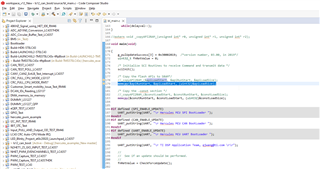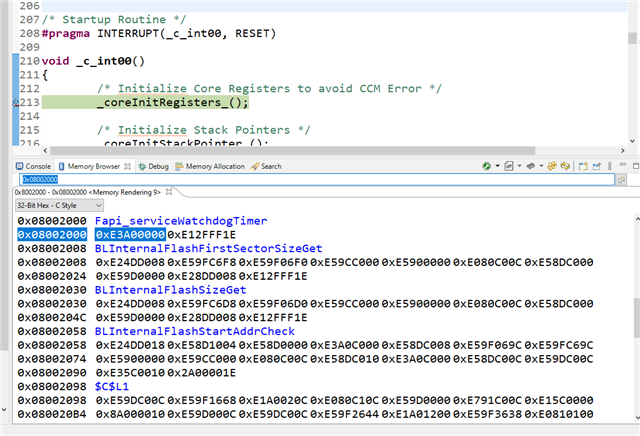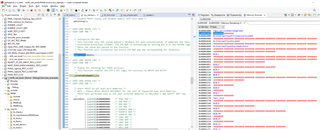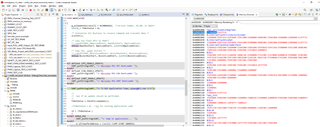Hi everyone,
I want to write data to some sectors of my code located at bank0. I use F021 Flash APIs for this process and get help from the UART bootloader source code previously written by TI (www.ti.com/.../spna192). A separate region named FLASH_API has been opened in the Uart bootloader source code, allowing F021 functions to be located on SRAM (0x08002000). I also performed these operations on my own code, but when I examined it with Memory Browser, these fields were assigned as 0x00, unlike the sample code.
UART bootloader example docs
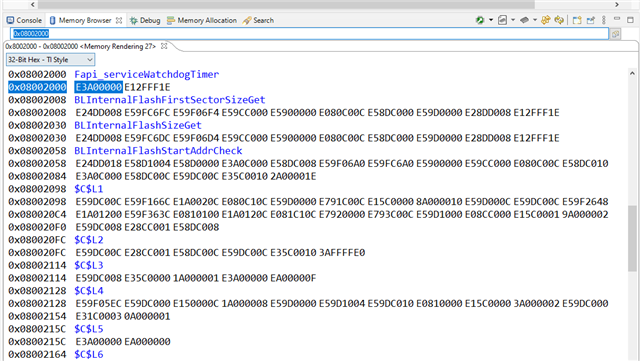
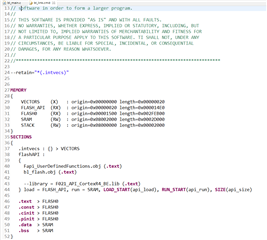
My code
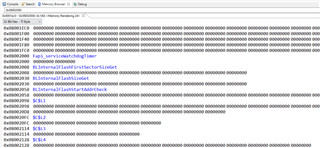
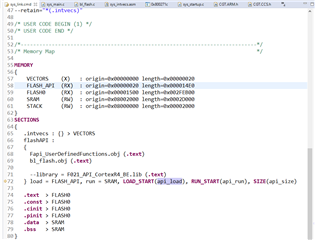
//*****************************************************************************
//
// bl_flash.c : The file holds the main control loop of the boot loader.
// Author : QJ Wang. qjwang@ti.com
// Date : 9-19-2012
//
// Copyright (c) 2006-2011 Texas Instruments Incorporated. All rights reserved.
// Software License Agreement
//
// Texas Instruments (TI) is supplying this software for use solely and
// exclusively on TI's microcontroller products. The software is owned by
// TI and/or its suppliers, and is protected under applicable copyright
// laws. You may not combine this software with "viral" open-source
// software in order to form a larger program.
//
// THIS SOFTWARE IS PROVIDED "AS IS" AND WITH ALL FAULTS.
// NO WARRANTIES, WHETHER EXPRESS, IMPLIED OR STATUTORY, INCLUDING, BUT
// NOT LIMITED TO, IMPLIED WARRANTIES OF MERCHANTABILITY AND FITNESS FOR
// A PARTICULAR PURPOSE APPLY TO THIS SOFTWARE. TI SHALL NOT, UNDER ANY
// CIRCUMSTANCES, BE LIABLE FOR SPECIAL, INCIDENTAL, OR CONSEQUENTIAL
// DAMAGES, FOR ANY REASON WHATSOEVER.
//
//*****************************************************************************
#include "bl_config.h"
#include "bl_flash.h"
#include "F021.h"
#include "flash_defines.h"
//#define Freq_In_MHz = SYS_CLK_FREQ;
//*****************************************************************************
//
// Returns the size of the ist sector size of the flash in bytes.
//
//*****************************************************************************
uint32_t
BLInternalFlashFirstSectorSizeGet(void)
{
uint32_t firstSectorSize;
firstSectorSize = (uint32_t)(flash_sector[0].start) + flash_sector[0].length;
return (firstSectorSize);
}
//*****************************************************************************
//
// Returns the size of the internal flash in bytes.
//
// This function returns the total number of bytes of internal flash in the
// current part. No adjustment is made for any sections reserved via
// options defined in bl_config.h.
//
// \return Returns the total number of bytes of internal flash.
//
//*****************************************************************************
uint32_t
BLInternalFlashSizeGet(void)
{
uint32_t flashSize;
flashSize = (uint32_t)flash_sector[NUMBEROFSECTORS-1].start + flash_sector[NUMBEROFSECTORS-1].length;
return (flashSize);
}
//*****************************************************************************
//
//! Checks whether a given start address is valid for a download.
//!
//! This function checks to determine whether the given address is a valid
//! download image start address given the options defined in bl_config.h.
//!
//! \return Returns non-zero if the address is valid or 0 otherwise.
//
//*****************************************************************************
uint32_t
BLInternalFlashStartAddrCheck(uint32_t ulAddr, uint32_t ulImgSize)
{
uint32_t count=0, i;
uint32_t ulWholeFlashSize;
//
// Determine the size of the flash available on the part in use.
//
ulWholeFlashSize = (uint32_t)flash_sector[NUMBEROFSECTORS-1].start + flash_sector[NUMBEROFSECTORS-1].length; /* 3MB */
/* The start address must be at the begining of the sector */
for (i = 0; i < NUMBEROFSECTORS; i++){
if ((ulAddr >= (uint32_t)(flash_sector[i].start)) && (ulAddr < ((uint32_t)flash_sector[i].start + flash_sector[i].length)))
{
count++;
}
}
if (count == 0){
return(0);
}
//
// Is the address we were passed a valid start address? We allow:
//
// 1. Address 0 if configured to update the boot loader.
// 2. The start of the reserved block if parameter space is reserved (to
// allow a download of the parameter block contents).
// 3. The application start address specified in bl_config.h.
//
// The function fails if the address is not one of these, if the image
// size is larger than the available space or if the address is not word
// aligned.
//
if((
#ifdef ENABLE_BL_UPDATE
(ulAddr != 0) &&
#endif
(ulAddr != APP_START_ADDRESS)) ||
((ulAddr + ulImgSize) > ulWholeFlashSize) ||
((ulAddr & 3) != 0))
{
return(0);
}
else {
return(1);
}
}
uint32_t Fapi_BlockErase( uint32_t Bank, uint32_t ulAddr, uint32_t Size)
{
uint8_t i=0, ucStartBank, ucEndBank, ucStartSector, ucEndSector;
uint32_t EndAddr, status;
EndAddr = ulAddr + Size;
for (i = 0; i < NUMBEROFSECTORS; i++){
if ((ulAddr >= (uint32_t)(flash_sector[i].start)) && (ulAddr < ((uint32_t)flash_sector[i].start + flash_sector[i].length)))
{
ucStartBank = flash_sector[i].bankNumber;
ucStartSector = i;
break;
}
}
for (i = ucStartSector; i < NUMBEROFSECTORS; i++){
if (EndAddr <= (((uint32_t)flash_sector[i].start) + flash_sector[i].length))
{
ucEndBank = flash_sector[i].bankNumber;
ucEndSector = i;
break;
}
}
status=Fapi_initializeFlashBanks((uint32_t)SYS_CLK_FREQ); /* used for API Rev2.01 */
for (i = ucStartBank; i < (ucEndBank + 1); i++){
Fapi_setActiveFlashBank((Fapi_FlashBankType)i);
Fapi_enableMainBankSectors(0xFFFF); /* used for API 2.01*/
while( FAPI_CHECK_FSM_READY_BUSY != Fapi_Status_FsmReady );
}
for (i=ucStartSector; i<(ucEndSector+1); i++){
Fapi_issueAsyncCommandWithAddress(Fapi_EraseSector, flash_sector[i].start);
while( FAPI_CHECK_FSM_READY_BUSY == Fapi_Status_FsmBusy );
while(FAPI_GET_FSM_STATUS != Fapi_Status_Success);
}
status = Flash_Erase_Check((uint32_t)ulAddr, Size);
return (status);
}
//Bank here is not used. We calculate the bank in the function based on the Flash-Start-addr
uint32_t Fapi_BlockProgram( uint32_t Bank, uint32_t Flash_Address, uint32_t Data_Address, uint32_t SizeInBytes)
{
register uint32_t src = Data_Address;
register uint32_t dst = Flash_Address;
uint32_t bytes;
if (SizeInBytes < 16)
bytes = SizeInBytes;
else
bytes = 16;
if ((Fapi_initializeFlashBanks((uint32_t)SYS_CLK_FREQ)) == Fapi_Status_Success){
(void)Fapi_setActiveFlashBank((Fapi_FlashBankType)Bank);
(void)Fapi_enableMainBankSectors(0xFFFF); /* used for API 2.01*/
}else {
return (1);
}
while( FAPI_CHECK_FSM_READY_BUSY != Fapi_Status_FsmReady );
while( FAPI_GET_FSM_STATUS != Fapi_Status_Success );
while( SizeInBytes > 0)
{
Fapi_issueProgrammingCommand((uint32_t *)dst,
(uint8_t *)src,
(uint32_t) bytes,
0,
0,
Fapi_AutoEccGeneration);
while( FAPI_CHECK_FSM_READY_BUSY == Fapi_Status_FsmBusy );
// while(FAPI_GET_FSM_STATUS != Fapi_Status_Success);
src += bytes;
dst += bytes;
SizeInBytes -= bytes;
if ( SizeInBytes < 16){
bytes = SizeInBytes;
}
}
return (0);
}
uint32_t Fapi_UpdateStatusProgram( uint32_t Bank, uint32_t Flash_Start_Address, uint32_t Data_Start_Address, uint32_t Size_In_Bytes)
{
register uint32_t src = Data_Start_Address;
register uint32_t dst = Flash_Start_Address;
unsigned int bytes, status;
if (Size_In_Bytes < 16)
bytes = Size_In_Bytes;
else
bytes = 16;
Fapi_initializeAPI((Fapi_FmcRegistersType *)F021_CPU0_REGISTER_ADDRESS, (uint32_t)SYS_CLK_FREQ);
Fapi_setActiveFlashBank((Fapi_FlashBankType)Bank);
Fapi_issueProgrammingCommand((uint32_t *)dst,
(uint8_t *)src,
(uint32_t) bytes, //8,
0,
0,
Fapi_AutoEccGeneration);
while( Fapi_checkFsmForReady() == Fapi_Status_FsmBusy );
status = Flash_Program_Check(Flash_Start_Address, Data_Start_Address, Size_In_Bytes);
return (status);
}
uint32_t Flash_Program_Check(uint32_t Program_Start_Address, uint32_t Source_Start_Address, uint32_t No_Of_Bytes)
{
register uint32_t *src1 = (uint32_t *) Source_Start_Address;
register uint32_t *dst1 = (uint32_t *) Program_Start_Address;
register uint32_t bytes = No_Of_Bytes;
while(bytes > 0)
{
if(*dst1++ != *src1++)
return (1); //error
bytes -= 0x4;
}
return(0);
}
uint32_t Flash_Erase_Check(uint32_t Start_Address, uint32_t Bytes)
{
uint32_t error=0;
register uint32_t *dst1 = (uint32_t *) Start_Address;
register uint32_t bytes = Bytes;
while(bytes > 0)
{
if(*dst1++ != 0xFFFFFFFF){
error = 2;
}
bytes -= 0x4;
}
return(error);
}
uint32_t Fapi_BlockRead( uint32_t Bank, uint32_t Flash_Start_Address, uint32_t Data_Start_Address, uint32_t Size_In_Bytes)
{
register uint32_t src = Data_Start_Address;
register uint32_t dst = Flash_Start_Address;
register uint32_t bytes_remain = Size_In_Bytes;
int bytes;
if (Size_In_Bytes < 16)
bytes = Size_In_Bytes;
else
bytes = 16;
Fapi_initializeAPI((Fapi_FmcRegistersType *)F021_CPU0_REGISTER_ADDRESS, (uint32_t)SYS_CLK_FREQ);
while( bytes_remain > 0)
{
Fapi_doMarginReadByByte((uint8_t *)src,
(uint8_t *)dst,
(uint32_t) bytes, //16
Fapi_NormalRead);
src += bytes;
dst += bytes;
bytes_remain -= bytes;
}
return (0);
}
extern void ramWriteEnable()
{
int a = 10;
(void)a;
}


